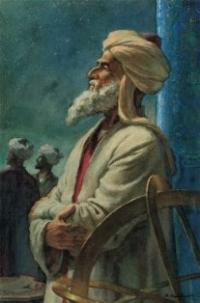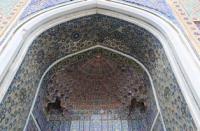You are here
Ulugbek madrasah.




Monuments in Central Asia and Uzbekistan.
“If diversity is a source of wonder, its opposite - the ubiquitous condensation to some blandly amorphous and singulary generic modern culture that takes for granted an impoverished environment - is a source of dismay. There is, indeed, a fire burning over the earth, taking with it plants and animals, cultures, languages, ancient skills and visionary wisdom. Quelling this flame, and re-inventing the poetry of diversity is perhaps the most importent challenge of our times”
Wade Davis.
Gastro tourism in Samarkand.
In 1417, the young king of Maverannahr, Mirzo Ulugbeg, the grandson of Amir Temur, initiated new construction projects in Samarkand, Bukhara, Shahrisabz and Ghijduvan. Caravanserais for itinerant traders formed part of the square even after the construction of the Ulugbek madrasa (1417 - 1420) on its west side.
Commissioned by and named after Tamerlane's astronomer son, who probably lectured here, this ancient seminary is appropriately decorated with а mosaic of stars over its enormous pishtak от portico.
Every other square inch of its exterior is covered in mosaic too, using virtually every motif permitted in Islamic art: floral ones sculpted into faience tiles around the niches and doorways, spirals up the pillars on the edges of the portico, bands of Kufic calligraphy round of the inside of the iwans (the high vaulted arches in the middle of each wing), and geometric patterns known as girikhs-some of them amazingly reminiscent of computer graphics on the rninarets and the facade.
The minarets were never used by muezzins; they were said instead to hold up the sky. The northern оnе is famous for its inward lean, attributed variously to architectural genius, the weight of the sky, earthquake damage and optical illusion.
Soviet engineers tried and failed to straighten it. The main door leads to а courtyard bounded by а mosque at the far end and two storeys of lecture halls and students' cells on the sides, but it's closed to visitors.
The madrasah occupied a rectangular area of 56 x 81 m. It was built from burnt bricks on ganch mortar. Inside there is an open square yard 30 x 40 m with octagonal hauz in the middle.
The front entrance, looking at Registan, is built in a form of a huge portal and crowned by enormous lancet arch with 15 m span length. The mosaic panel above the arch symbolically represents heavens with five- and ten-pointed stars.
At the corners of the portal there are two small auditoria of two-storey in height. Opposite the madrasah there is mosque. Madrasah has dwelling hudjras (cells) on two floors. Before construction of Ulugbeg’s observatory, the madrasah had the ground for astronomic observations.
Figured tiles with majolica coated the walls. Some of them have dates – 1417, 1419, 1420. Originally, madrasah consisted of 50 cells where could live 100 students. Among outstanding students of the madrasah were naqshbandi sheikh Khodja Akhrar and Sufi poet Djami.
In Samarkand, the people clearly realized connection of the new madrasah and the king, who personally taught there. Up to this day, the madrasah has kept the name of Ulugbeg. When in spring 1450, the son and murderer of Ulugbeg, Abdullatif was executed, his head was exhibited on the madrasah of his father as a symbol of triumph of justice and return to traditions of Ulugbeg.
By the XVIII century, madrasah had been damaged. The second floor and domes at the sides of portal were dismantled. By the XX century, the most part of mosaics on facades had been lost.
All that required serious restoration works to preserve the outstanding architectural monument. In 1932, the north-eastern minaret was restored, and in 1965 – the south-eastern. Their domes were installed newly.
The portal arch and tympan were re-installed. Opposite the madrasah, on the place of modern Sher-Dor, Ulugbeg constructed Sufi khanaka. Babur titled its dome as “the biggest in the world”.
Architectural opposition of the madrasah and khanaka reflected actual dualism of Islamic spiritual and natural-scientific education and mystic Sufi knowledge. In khanaka of Ulugbeg or beside it was located the tomb of Imam Muhammad ibn Djafar, related to the IX - X c.c.
Authority:
Alexey Arapov. Samarkand. Masterpieces of Central Asia. Tashkent, San’at. 2004.
Photos
Alexander Petrov.







